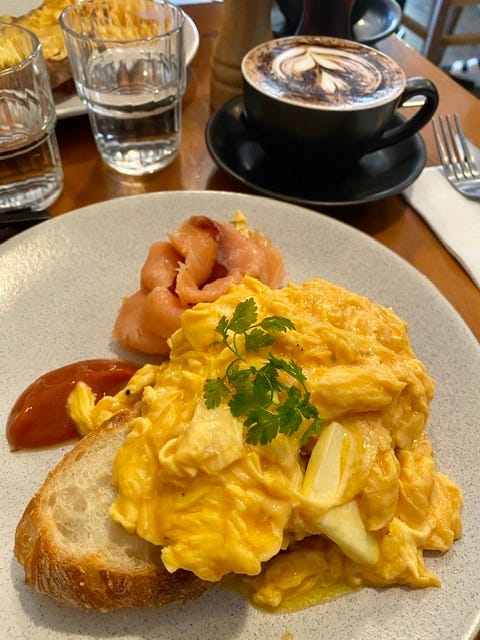If you’re reading this, I am probably eating scrambled eggs. No. Seriously. I’m pretty much always eating scrambled eggs. A champion at the breakfast table, naturally, they’re also personal faves for lunch and dinner when I can’t be bothered thinking of anything else to eat.

The eggs above are from Sisco in Spring Hill, where I have a post-gym breakfast three times a week. They are, I believe, the finest scrambled eggs in the city. I remember when we were coming out of lockdown and warily venturing back into cafes, I was struck by how many places seemed to have forgotten the noble art of whisking a couple of googs into high protein heaven. For a couple of weeks there I was getting these bland, lifeless malarial yellow slabs of semi-dried scramble-fail.
But not at Sisco.
They nailed it straight out of the lockdown gate. Their version has the creamy density and heaviness I prefer with none of the dry, airy insubstantiality you get in eggs that have been whipped like a red-headed stepchild and burned like a Trump Tower subcontractor. They come atop a couple of slabs of toasted sourdough which is good enough to be worth an entry all on its own, and I usually match them with either halloumi or smoked salmon.
I can get by on just a protein shake for lunch after feasting like a king on these bad boys.
I will admit to being a bit crap at making them myself, which is why I can’t be too hard on those places which don’t get them exactly right. This Washington Post guide hits pretty much all the grace notes for getting them right, especially keeping a close eye on the amount of heat you’re putting in. Less. Less is always better.
Manage the heat. “The key to most good egg dishes is temperature control,” McGee writes. And the biggest danger in scrambled eggs is too much heat, which, as we’ve established, leads to unappealing textures. But playing around with heat also gives you control over what style of scrambled eggs you want. If you like fluffy curds, you need heat to produce steam and cause the eggs to expand. The key is how much and how long. In Cook’s Illustrated, Dan Souza found that a combination of high and low heat helped achieve voluminous but still tender eggs — start at medium-high and drop to low once a spatula dragged through the skillet left very little raw egg in the trail.
For denser eggs with few or almost no curds, work entirely over low heat. Using a saucepan, too, helps keep moisture from evaporating as much.
I’m back at jujitsu a couple of nights a week again, which means upping my scrambled egg game at the end of the day to match Sisco at the start.
Gonna see if I can get close to their standard.




I, for one, am now hungry.
Possibly inciting some kind of egg war, the WaPo guide is pretty good, although I add getting your pan to temperature before adding anything to it, including the butter, and just pushing your eggs around rather than stirring. Pushing will give you the look above. I also use a cast iron frying pan. If you do it right you should barely even need to clean the pan.